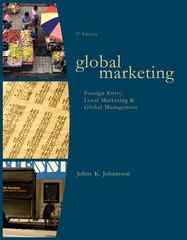Question
Drugmakers Raise Prices of Ozempic, Mounjaro and Hundreds of Other Drugs Companies hiked prices of 775 brand-name drugs at start of new year Jan. 18,
Drugmakers Raise Prices of Ozempic, Mounjaro and Hundreds of Other Drugs
Companies hiked prices of 775 brand-name drugs at start of new year
Jan. 18, 2024
Drugmakers kicked off 2024 by raising the list prices for Ozempic, Mounjaro and dozens of other widely used medicines.
Companies including Novo Nordisk, the maker of Ozempic, and Eli Lilly, which sells Mounjaro, raised list prices on 775 brand-name drugs during the first half of January, according to an analysis for The Wall Street Journal by 46brooklyn Research, a nonprofit drug-pricing analytics group.
The drugmakers raised prices of their medicines by a median 4.5%, though the prices of some drugs rose by around 10% or higher, according to the research group. The median increase is higher than the rate of inflation, which ticked up to 3.4% in December.
Price hikes above inflation for big-selling medicines, in particular, are likely to sharpen scrutiny of the industry just as the Biden administration is taking new steps to rein in the federal government's drug spending, including plans to start negotiations over pricing.
To blunt criticism from patients, doctors and lawmakers, drugmakers aren't raising prices as much as they had in years past. Yet the latest round of increases mean some already expensive drugs will cost hundreds or even thousands of dollars more a month, which could fuel fresh calls for containing the spiraling costs.
Among the notable increases: The price for Ozempic, a diabetes treatment that many people are taking to lose weight, went up by 3.5% to nearly $970 for a month's supply. Mounjaro, a diabetes drug in the same class that is also widely used for weight loss, climbed 4.5% to almost $1,070 a month.
Novo Nordisk said list-price changes take into account factors such as market conditions and inflation, and its U.S. list-price increases haven't reached above single-digit percentages since 2016. Lilly said it sets prices according to a medicine's value, efficacy and safety.
The hikes anger patients and doctors, though drugmakers usually discount the price of their drugs to win reimbursement from health plans, and patients who have health insurance typically pay only a portion of the cost.
Last year, the U.S. government began imposing penalties on companies that raised the list prices of medicines above the rate of inflation. This year, it is scheduled to begin the first-ever negotiations with companies over the prices of 10 drugs including popular blood-thinner Eliquis.
Inflation and investment in research and innovation contributed to the company's list-price increases, a Bristol spokeswoman said. The price paid to the company will "remain nearly flat" this year because of rebates and discounts, she said, and half of patients pay $40 or less a month.
Health plans, which pay most of the cost of drugs for most Americans, don't usually pay list prices. They typically negotiate discounts with drugmakers in exchange for agreeing to cover prescriptions and let plan members take them.
Because of the discounting, pharmaceutical companies have said they often don't make more money by raising prices. Rather, the drugmakers have said they raise the list prices to give bigger discounts and ensure their products are covered by the health plans.
Questions:
- Among the determinants of the price elasticity of demand for a product are the availability of close substitutes, whether the product is a luxury or a necessity and the share of the product in a consumer's budget. State whether the demand for a product will be relatively elastic or relatively inelastic if: (a) there are several close substitutes for the product; (b) consumers consider the product to be a necessity; (c) spending on the product is a large share of consumers' budgets. (3 points)
- From the article: "The drugmakers raised prices of their medicines by a median 4.5%, though the prices of some drugs rose by around 10% or higher..." If an increase in the price of a medicine results in an increase in sales revenue would this mean that the demand for the medicine is elastic or inelastic? Explain your answer. (3 points)
- From the article: "The price for Ozempic, a diabetes treatment that many people are taking to lose weight, went up by 3.5% to nearly $970 for a month's supply. Mounjaro, a diabetes drug... that is also widely used for weight loss, climbed 4.5% to almost $1,070 a month." Holding other determinants of the price elasticity of demand constant, for whom would the demand for Mounjaro be more elastic: (a) Mark, who has an annual income of $100,000, or (b) Margaret, who has an annual income of $1,000,000? Briefly explain your answer. (3 points)
- Studies show that doubling the price of specific prescription drugs resulted in an average 6% reduction in quantity demanded, what was the percentage change in revenue for the drug manufacturer? In general, does revenue increase or decrease if the demand curve is perfectly inelastic at the initial price? (5 points)
Step by Step Solution
There are 3 Steps involved in it
Step: 1

Get Instant Access to Expert-Tailored Solutions
See step-by-step solutions with expert insights and AI powered tools for academic success
Step: 2

Step: 3

Ace Your Homework with AI
Get the answers you need in no time with our AI-driven, step-by-step assistance
Get Started


